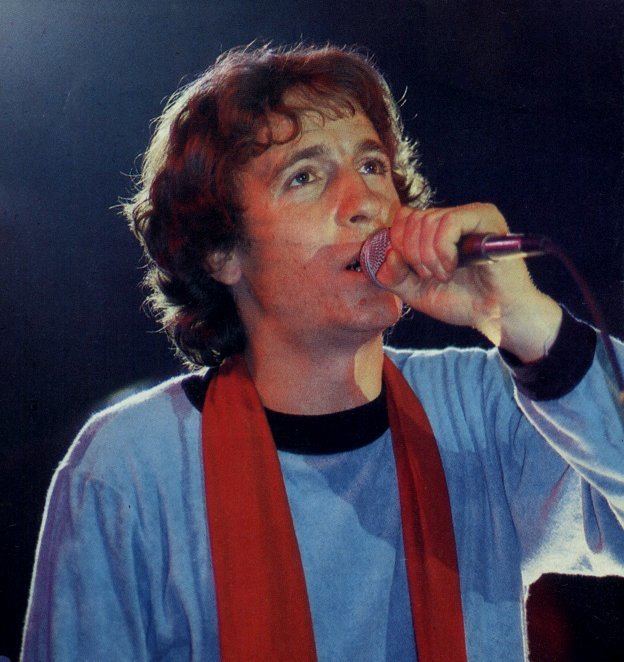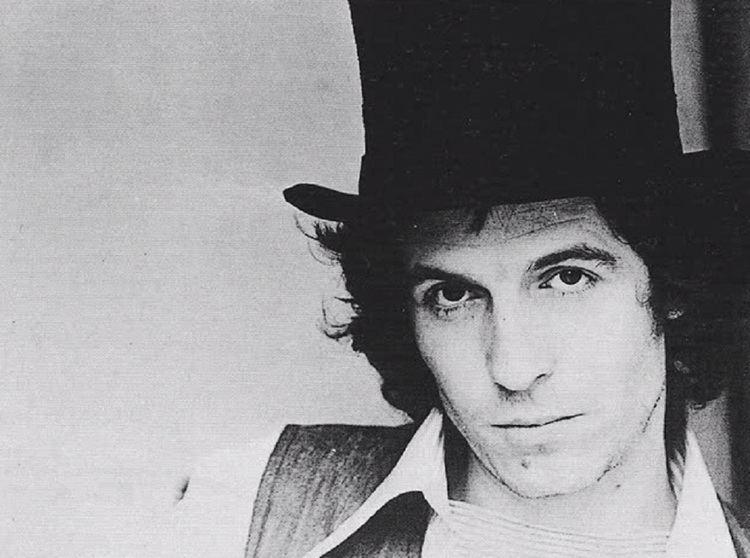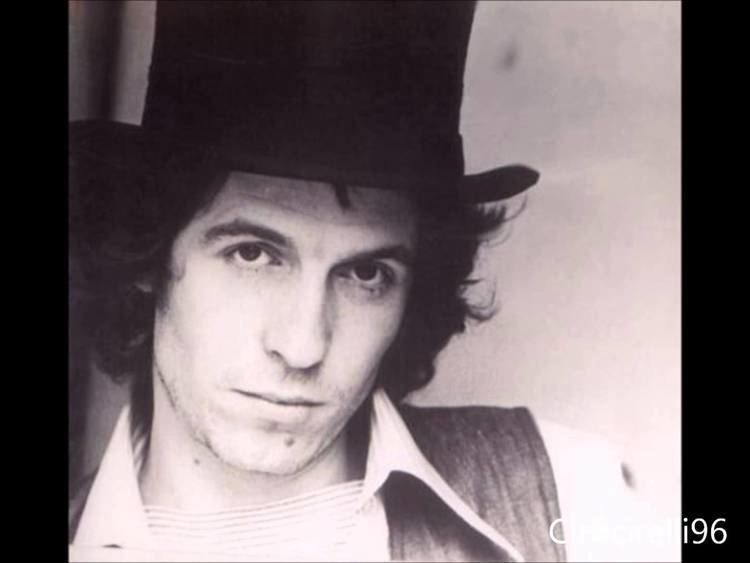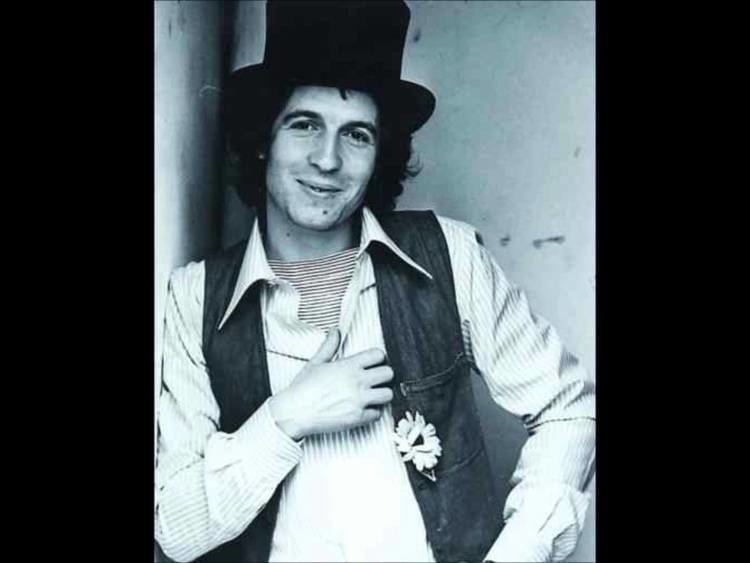Also known as Rino Gaetano Years active 1973–1981 Name Rino Gaetano | Occupation(s) Singer-songwriter Role Musician | |
 | ||
Birth name Salvatore Antonio Gaetano Born 29 October 1950Crotone, Italy ( 1950-10-29 ) Siblings Anna Gaetano, Giuseppe Gaetano Albums Ingresso libero, Sotto i cieli di Rino, Gianna e le altre, Sotto i cieli di Rino Special E, Live & Rarities | ||
The film rino gaetano in 2010 at rtsh film premier
Salvatore Antonio "Rino" Gaetano (29 October 1950 – 2 June 1981) was an Italian musician and singer-songwriter. He is famous for his satirical songs and oblique yet incisive political commentary. He is remembered for his rough voice, the biting irony of his songs and social protest hidden behind seemingly light lyrics. While he avoided taking any sides politically and refused to be labelled, his songs are full of political commentary. He died in a car accident at the age of thirty. His songs, however, are still widely sung and played, and he is still a popular and influential figure.
Contents
- The film rino gaetano in 2010 at rtsh film premier
- Gianna Rino Gaetano Classical Guitar Arrangement by Giuseppe Torrisi
- Biography
- Mio fratello figlio unico and Aida
- Sanremo Music Festival
- Nuntereggae pi and controversy
- Final albums
- Death
- Studio albums
- Live albums
- Compilations
- Singles
- In popular culture
- References

Gianna - Rino Gaetano (Classical Guitar Arrangement by Giuseppe Torrisi)
Biography

Salvatore Antonio Gaetano was born in Crotone, in the southern Italian region of Calabria. His family called him "Salvatorino", an affectionate nickname which translated into English would be 'Little Salvatore'. His sister Anna however preferred the name 'Rino' and it stuck.

In March 1960, at the age of nine, his family moved to Rome, where he would spend the rest of his life. In 1961, he was sent to study at the seminary Piccola Opera del Sacro Cuore of Narni, in the province of Terni, where under the guidance of his teacher Renato Simeoni, he began to show his flair for writing poetry. By 1967 he had finished school and living back in Rome, he created a quartet with a group of friends called Krounks, who would mainly play cover songs. They were inspired by Italian artists such as Enzo Jannacci, Fabrizio De André, Adriano Celentano, I Gufi, Gian Pieretti and Ricky Gianco as well as international musicians such as Bob Dylan and The Beatles.

In 1969, Rino approached Folkstudio, a well-known club in Rome for promoting young artists. Rino's style proved to be very different from that of the other musicians. His strong use of irony caused concerns for the club managers, as Rino recounted:

"When I sang at Folkstudio, it was the centre of discussions....in fact they did not want me to do many of my pieces because they thought I wanted to make fun of everyone."

However, Rino was a multi-talented performer and during the early 1970s, in addition to gigging, he performed in cabarets and took part in several plays including playing the role of Estragon in Samuel Beckett's Waiting for Godot, the Fox in a production of Pinocchio by the legendary Italian director Carmelo Bene and reciting poetry by Majakovsky.
Gaetano was an accomplished actor and it was through his theatre experience that he developed much of his subsequent stage style and writing technique. He was inspired by German kabarett, a form of theatre that excels in political satire. Wikipedia describes this as "unlike comedians who make fun of all kind of things, Kabarett artists (German: Kabarettisten) pride themselves as dedicated almost completely to political and social topics of more serious nature which they criticize using techniques like cynicism, sarcasm and irony." They were able to deal with social themes and political developments through their acts, something that inspired Gaetano and can be seen in many of his concepts and staging, for example, in his song Aida/Spendi spandi effendi regarding the oil crisis of the 1970s. It enabled him to make political observations while avoiding censorship. Gaetano cited Ionesco as his favourite playwright, one of the foremost writers of Theatre of the Absurd, saying that he explored the usual problem of the inability to truly communicate, isolation and exclusion. He developed a comedy act with his friend Bruno Francelleschi, 'Ad esempio a me piace...' (For example, I like...), as a mixture of theatre and music.
In addition to his performing, Rino studied accountancy, encouraged by his father to pursue a secure career in banking. Rino asked for one more year to break into music and in 1972, he recorded his first 45 rpm record with the Milan-based Produttori Associati containing the songs Jacqueline and La ballata di Renzo, the song with famously features lyrics that echo details of Gaetano's death. The disc was not printed and Rino signed with Vincenzo Micocci, releasing his first single in 1973, I love you Maryanna/Jaqueline (with "Jaqueline" on the B-side) produced by RosVeMon, the surnames of Aurelio Rossitto, Antonello Venditti and Piero Montanari. In this song, Gaetano exhibits his multicultural education, singing in four languages - English, Italian, German and French. Rino decided to release the single under the pseudonym of Kammamuri's as tribute to a character in Pirates of Malaysia by Emilio Salgari. According to Micocci the choice of using a pseudonym was a sign of shyness and insecurity of Gaetano:
"He considered himself a writer, not a singer. He believed he didn't have a good voice, so that after the release of I Love You Marianna, when the time came to record his first album, he came and told me that it would be better to get someone else to sing the songs. I, of course, I laughed and sent him in the studio."
In 1974, he published his first album, Ingresso libero. The LP featured many of the themes that would characterise his work, such as issues of isolation, marginalisation and exclusion, as well as his lively style and intelligent, witty lyrics. His songs began to be played on radio stations and in the same year, through record company RCA, Rino wrote three songs for Nicola Di Bari Prova a chiamarmi amore, Questo amore così grande and Ad esempio a me piace... il Sud, included in the album Ti fa bella l'amore. The Spanish version of Ad esempio a me piace... il Sud, Por ejemplo, achieved great success in Latin America.
Success for Gaetano came the following year with the 45 rpm hit record Ma il cielo è sempre più blu (But the sky is always bluer), perhaps now the most famous and instantly recognisable of all his songs. Unusually, the 45 contained only one song, but it was split into two. In this song Rino, offers several pictures of everyday life, between irony, clichés and contradictions. In September 1975, the singer explained some of this thinking in an article in the weekly Italian music magazine, Ciao 2001: "These pictures are sad, never happy, because I wanted to emphasise that nowadays there are few cheerful things and it is for this reason that I take into account those who die at work. Even the verse "who plays Sanremo" is sad and negative, because anyone who plays Sanremo, doesn't think of those who "live in barracks".
Mio fratello è figlio unico and Aida
In 1976 Rino recorded his second album, Mio fratello è figlio unico (My Brother is an Only Child). With this album, the Calabrian singer tries to capture the listener's attention with dramatic narratives, especially loneliness and alienation, the main themes of the album. On the album, Rino began to explore new sounds and instruments including the sitar, the banjo and the mandolin, enabling him to obtain a more complex and mature album. In a review published by Ciao 2001 shortly after the album's release, it states that:
"His second album, Mio fratello è figlio unico, already widely programmed by radio stations, is much more mature and personal than his previous album. Rino is an atypical figure: there is the difficulty of finding genres to fit him into, trends in which to place him, which is the best compliment that you can give. The music, made a few chords, is built intelligently and pleasantly. The voice is aggressive, deliberately crude words are fun, the lyrics have allegories, the visual images are faster, like photography." (Enzo Caffarelli)
The following year Rino recorded his third album, Aida. The choice of the name refers to the work of the great Italian opera composer Giuseppe Verdi, but for Gaetano, Aida is the embodiment of all women and of Italy itself. Through the figure of Aida, Rino researches and recounts moments in Italian history with a completely original, almost photographic, observation. While on tour, Gaetano was joined by the emerging band, Crash, and he produced their album Exstasis and wrote their song "Marziani noi" (Us Martians). With his increasing rise in popularity, he made his first major television appearance on the entertainment programme, Domenica in (Sunday), presented by the legendary Italian TV presenter Corrado Mantoni, singing "Aida/Spendi spandi effendi" and on 19 August, he was invited to appear on a programme with Gino Paoli where he famously appeared bearing a petrol pump and wearing a striped T-shirt and a colonial style safari hat.
Sanremo Music Festival
Although not generally recognised outside of Italy, the Sanremo Music Festival is a popular annual song contest. Due to its pop music roots and pop culture positioning, it was not felt to be a route for a serious musician. However, pressure from RCA encouraged Gaetano to take part. He chose his new song Nuntereggae più/E cantava le canzoni. It was a highly innovative half-sung/ half-spoken proto-rap against several Italian sportsmen, politicians and other high-profile figures. However, the producers of the show forced him to drop the song, due to its now famous list of prominent Italians which it criticised, and swap the song with Gianna/Visto che mi vuoi lasciare On the 26th January 1978, Rino Gaetano appeared on stage at Sanremo wearing a top hat, evening dress featuring medals, red and white sneakers and bearing a ukulele. The performance of Gianna, also included the first time the word 'sex' was used onstage at Sanremo. Towards the end of the song, the band Pandemonium appeared unexpectedly onstage to sing the chorus.
Later discussing his performance at Sanremo, Gaetano remarked: "The festival is a walkway and like all walkways, it gives you three minutes to make a speech that you would normally do in a two hour show. So you have to find a way. For my part, I have chosen the way of paradox, a bit like Carmelo Bene." (Rino vive - Ma il cielo è sempre più blu, RAI 2, 2007)
Bruno Franceschelli recalls the event: "The performance in Sanremo, from my point of view, was a demonstration of his talent as an artist. He brought a new air, funny and irreverent, and once again demonstrated his free spirit, free to laugh and joke on the 'sacred soil' of Sanremo."
The song went on to dominate the charts for several weeks. It remained in the Top Ten for 14 weeks and sold over 600,000 copies. A version of the song in German was released by Wolfgang Petry.
Nuntereggae più and controversy
In the same year Rino appeared on Rai Radio 1 radio programme Canzone d'Autore (Songwriters). During the programme, emerging musicians are invited to comment on their own songs. The programme was called "E cantava le canzoni", a title taken from the fourth album of the singer.
On the same album is the now notorious Nuntereggae più, and Gaetano was asked to discuss it because of the numerous political references and the long list of names in the lyrics. He replied, "The songs are not political texts and I do not make speeches. This is just teasing. So, for me, "Nuntereggae più" is the lightest song I've ever done ".
Some verses of the song contain lists of names of people who at that time were prominent on the radio, television and newspapers. Some of the names included in the first version were deleted or replaced. For example, in the original version, written before his kidnapping, appeared the name of Aldo Moro. As a result of subsequent events, the name was later deleted from the text of the song, so as to avoid creating controversy. But other names were also deleted including the journalist Indro Montanelli, the actor Lino Banfi, Sinatra, Michele Sindona (Italian banker and convicted criminal) and the president of the Italian defence company Finmeccanica Camillo Crociani who was involved in the Lockheed scandal and the illegal Masonic Propaganda Due (P2) lodge. [41] Vincenzo Mollica recalls: "Nuntereggae is a song of great fun, but [Gaetano] had the courage of his actions, he never drew back. "
In that year Rino participated in a tour and some evening events, the most famous of these is definitely Discomare '78 and specifically the final night held in the Valley of the Temples in Agrigento on 23 August 1978. The singer was supposed to sing Nuntereggae more, but Rai tries to stop him and Rino in protest leaves the event. In October Rino goes to Madrid to record the Spanish version of the 45 Nuntereggae more. The title chosen is Short and roll ya (From a cut) and singer adapts the text by inserting characters of Spanish politics and entertainment as Carrillo , Pirri and Susan Estrada . The album will be released in the spring and get some success.
Final albums
1979 sees the release of Gaetano's fifth studio album, Resta vile maschio, dove vai? and his first with RCA. Rino took part in his first Festivalbar and then, in October, he attended the Discoestate in Rieti. On this occasion, in protest at having to sing along to playback, when the music starts, instead of pretending to sing, he decides to act indifferent and smokes a cigarette.
Also in 1979, during a concert on the beach in Capocotta (in fact also mentioned in the lyrics), before singing Nuntereggae più, Rino is said: "There's someone who wants to put a gag on me! I do not fear them! They will not succeed! I feel that, in the future, my songs will be sung by future generations, that, thanks to mass communication, they will understand what I mean tonight! They will understand and open their eyes, rather than having them full of salt! And you wonder what happened on the beach Capocotta." Gaetano was referring to the murder of Wilma Montesi.
In 1980, he recorded his final album E io ci sto noted for its serious tone and rock sound. In 1981, RCA organised a tour, from which the live Q Concert album was created. In 1981, he also played the role of the Fox from Pinocchio in a movie directed by Carmelo Bene and filmed in Rome.
Death
On 31 May 1981 Rino made his last appearance on TV singing E io ci sto.
The career and life of Rino Gaetano were interrupted on 2 June 1981, at the age of thirty, as a result of a car accident. He had already been in a traffic accident earlier that year on 8 January, when a jeep had driven the wrong way along the road and pushed Rino's Volvo against the guardrail: the singer was unharmed while his car was completely destroyed.
Rino had finally decided to buy a new Volvo 343 in metallic gray. On 2 June, at about 3 am, Rino was returning home alone in his car. At 3.55 am, while along Rome's Via Nomentana, at the intersection of Viale XXI Aprile, he was in collision with a van. The front and right side of the Volvo were destroyed. When help arrived, Rino was already in a coma and at the hospital, an x-ray showed a fracture at the base of the skull, various wounds to the forehead, a fractured right molar and a suspected fracture of the sternum. However, the clinic did not have a department for cranial injuries and the doctor on duty, Dr. Novelli, tried in vain to contact another hospital with a cranial trauma department. He contacted by phone St. John, St. Camillus, the CTO of Garbatella, the Policlinico Gemelli and San Filippo Neri, but could not get any assistance. At 6am, Rino Gaetano died. There was a great deal of controversy about this accident, because of the failure of any of the contacted hospitals to help Gaetano and thus, an investigation was launched.
On 4 June his funeral was held in the Church of the Sacred Heart of Jesus, in which Rino had planned to get married. His funeral was a big event, attended by many relatives, friends, members of the music industry, RCA executives and fans. Initially he was buried in the small cemetery of Mentana, but on 17 October his body was transferred to the Verano cemetery, where his body remains.
In recent years, the lyrics of the unpublished song La ballata di Renzo (The Ballad of Renzo) has drawn a lot of attention - a song written by Rino more than ten years before his death. This song tells the story of a boy named Renzo, who died under similar circumstances. Renzo is hit by a car and dies after being rejected by many hospitals in Rome for lack of space, while his friends are at the bar. The song even references three of the hospitals that refused to treat Rino on 2 June 1981 due to lack of beds: General Hospital, San Giovanni and San Camillo. This is still a topic of popular discussion. Rino's death was discussed on 27 November 2007 in a short radio program broadcast on Radio DeeJay by Carlo Lucarelli, who uses a writer-documentary narrative form to reconstruct unsolved crimes related to the world of music.
The first book on his life, also the first official biography, was published in 2001, 20 years after his death.
